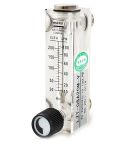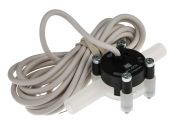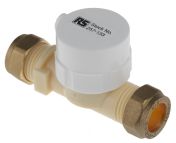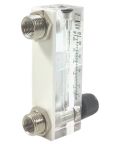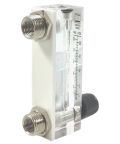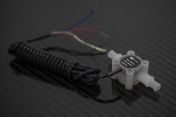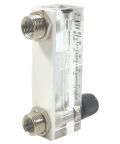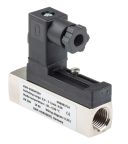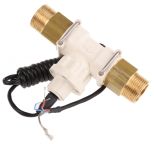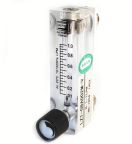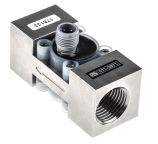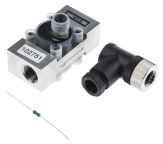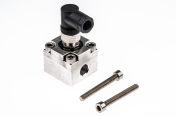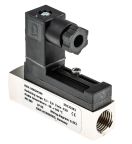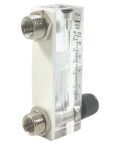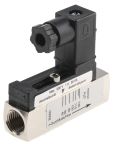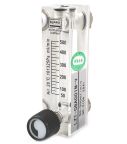Flow Sensors
Flow sensors are devices that help us measure the movement of fluids, like water or air, in various applications. You may have heard of them being referred to as a flow meter or flow indicator. They work like fluid detectives, detecting the flow rate and volume with certain applications to provide valuable information for controlling, monitoring, and optimising processes.
The operating principle of flow sensors varies depending on the specific type and application. These sensors employ a range of working principles tailored to different materials and scenarios. Typically, a flow meter comprises three key components: the sensor, signal processor and transmitter. Fluids pass through the sensor, where their volume or mass per unit of time is meticulously tracked. This data is then translated into signals interpreted by the transmitter, yielding precise measurements of flow.
While the standard methodology remains consistent, diverse types of flow sensors employ alternative techniques and yield varying units of measurement. Some common units include litres per second, gallons per minute, and cubic centimetres per minute.
This ability to monitor flow rates cannot be overstated across industries. This is because accurate flow rate measurements aid with operational efficiency, facilitating cost-savings and process optimisation. Whether in manufacturing, chemical processing, or environmental monitoring, flow rate measurement plays a pivotal role in several key areas:
- Process Control: Industries rely on precise flow rate measurements to control and optimise production processes. Maintaining the correct fluid flow ensures that each stage of the process receives the appropriate amount of material, preventing defects, wastage, or delays.
- Quality Control: In sectors like food production and pharmaceuticals, maintaining consistent flow rates is vital for ensuring product quality and safety. Accurate flow rate measurements guarantee precise ingredient dosing, minimising batch variations and contamination risks.
- Environmental Monitoring: Flow rate measurements are indispensable in tracking and mitigating environmental pollution. Whether monitoring water, air, or gas emissions, these measurements aid in quantifying pollutants, aiding in pollution prevention and regulatory compliance.
- Energy Management: Effective management of energy resources relies on accurate flow rate measurements. Whether it's optimising oil, gas, or water usage, precise flow monitoring helps reduce waste and minimise operational costs.
From the above, it is clear that flow sensors are the "current" stars of the measurement world, helping us formulate efficient processes, optimise resource usage, and maintain the perfect balance. With their diverse types and applications, they're certainly not "fluid" when it comes to providing valuable data.
Types of Flow Sensors
As mentioned, there are several types of flow sensors, each with its unique way of working.
Differential Pressure Flow Sensors
Differential pressure sensors create a pressure drop in the fluid and measure the resulting difference. They compare the pressure upstream and downstream of an obstruction, calculating the flow rate. They're commonly used in HVAC systems and industrial processes.
Turbine Flow Meters
Turbine flow meters work like tiny windmills in the fluid stream. As the fluid flows, it spins the turbine, and the speed of rotation is proportional to the flow rate. These sensors are widely used in water utilities, irrigation systems, and even fuel consumption monitoring.
Electromagnetic Flow Meters
The electromagnetic flow meter employs the power of electromagnetism to measure flow. A magnetic field is created perpendicular to the fluid's direction, and as the conductive fluid flows, it generates a voltage proportional to the velocity. They are unaffected by pressure or temperature changes and find applications in water treatment, chemical processes, and wastewater management.
Ultrasonic Flow Meters
These flow meters use sound waves to detect the flow. They emit ultrasonic signals through the fluid and measure the time it takes for the waves to travel upstream and downstream. By comparing these times, they calculate the flow rate. These sensors are particularly handy for large pipes and ducts.
Vortex Flow Meters
Just as a whirlpool forms when water flows past an obstacle, vortex flow meters take advantage of the "twist" in the flow. They place a bluff body in the fluid stream, and the frequency of vortices formed is directly related to the flow rate. These sensors excel in measuring gas flow and find applications in HVAC, chemical plants, and even beer brewing!
Types of Monitored Media
From air to liquids besides water, a range of substances falls under the scrutiny of flow sensors across many industries and applications. Each monitored medium poses distinct challenges and requirements, driving the development of specialised sensor technologies tailored to accommodate their unique characteristics and operational needs. Consider this spectrum of monitored media and the specialised sensors meticulously engineered to ensure precise measurement of their flow rates:
- Air: One of the most commonly monitored gases, air flow measurement is crucial in HVAC systems, automotive applications, and environmental monitoring. Air flow meters often use thermal, ultrasonic, or differential pressure methods to measure the flow rate.
- Argon: As an inert gas, argon is frequently used in industrial processes, particularly in welding and manufacturing under controlled atmospheres. Argon flow measurement requires sensors that can handle inert gases accurately, typically using mass flow or thermal flow meter technologies.
- Carbon Dioxide (CO2): Monitoring CO2 flow is essential in industries like beverage carbonation, indoor air quality assessment, and controlled atmosphere storage. CO2 sensors must be able to handle the density and pressure characteristics of the gas, often employing thermal or mass flow metering technologies.
- Dry Air: Specifically refers to air with low moisture content, crucial in applications where water vapour can interfere with processes, such as in laboratories or electronic manufacturing. Flow sensors for dry air need to be sensitive to the absence of humidity to maintain accuracy.
- Dry Gas: Similar to dry air, dry gas is any gas that is free from moisture. Its flow is typically monitored in gas supply lines in chemical processes or power plants using technologies that can accurately measure flow without interference from moisture.
- Fluid: Encompasses a wide range of liquids, from water to chemical solvents. Fluid flow measurement is integral to industries like water treatment, pharmaceuticals, and food processing. Depending on the fluid's viscosity and chemical properties, different flow meter technologies like turbine, paddlewheel, or electromagnetic might be used.
- Gas: A broad category that includes any gaseous substance, such as natural gas or nitrogen. Gas flow measurement is critical for safety and efficiency in sectors like the petrochemical industry, utilities, and healthcare. Various flow meter types, including vortex, ultrasonic, and thermal mass flow meters, are utilised based on the specific gas properties.
- Helium: Known for its low density and high diffusion properties, helium is often used in leak detection systems and cryogenics. Helium flow meters usually use mass flow technologies to ensure precise measurements due to the gas's unique physical characteristics.
How to Order Flow Sensors From RS?
RS is your reliable source for an expansive selection of flow sensors featuring top brands such as RS PRO, Gems Sensors,Sick, Sensata, and Siemens. In addition, we offer other industrial solutions, such as sensor accessories like sensor brackets and inductive sensors that ensure quality control in manufacturing.
For those who prefer traditional methods or require a more personalised service, RS also accepts offline orders via telephone, email, or fax.
With our user-friendly ordering system, acquiring sensors for your requirements is a seamless process complemented by swift and efficient delivery options. For more information, refer to our delivery page.
Delivery Information for Australia
RS offers a range of reliable delivery options across Australia, ensuring your orders arrive on time and in excellent condition.
Place your order before 5 pm AEST on weekdays for next-day delivery on locally stocked items. In addition, please note, some regional areas or orders that include hazardous products, heavy items, or those exceeding certain dimensions may have extended lead times.
Explore our delivery information page for a detailed breakdown of our delivery options, including any exceptions and specialised services such as same-day delivery and consolidated shipments.
Popular Searches
Related links
- Choosing the Right Flow Meter for Water Management Needs
- SMC PF3W Series Digital Flow Switch For Water Flow Sensor for Fluid 2 l/min Min, 16 L/min Max
- ifm electronic SM2 Series Magnetic Inductive Flow Meter Flow Meter for Water 9600 gph Max
- ifm electronic SV Series Vortex Flow Meter Flow Meter for Water 40 L/min Max
- ifm electronic SM7 Series Magnetic Inductive Flow Meter Flow Meter for Water 792 gph Max
- RS PRO Radial Flow Turbine Flow Meter for Liquid 6.5 L/min Max
- Sensirion SFM3013-300-CLM Series Digital Flow Meter Flow Sensor for Gas 300 slm Max
- The Complete Guide to Flow Switches
